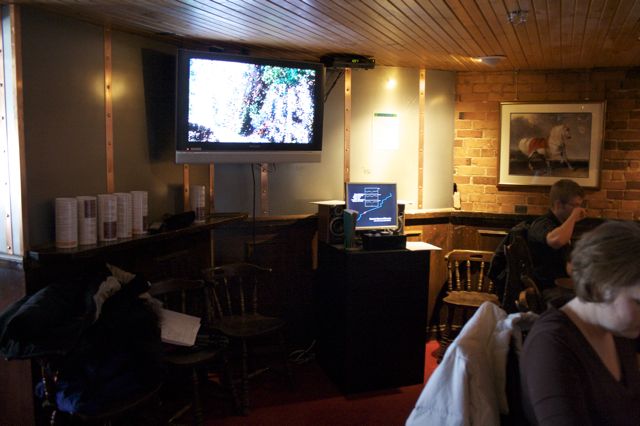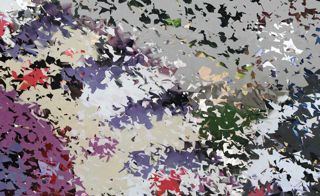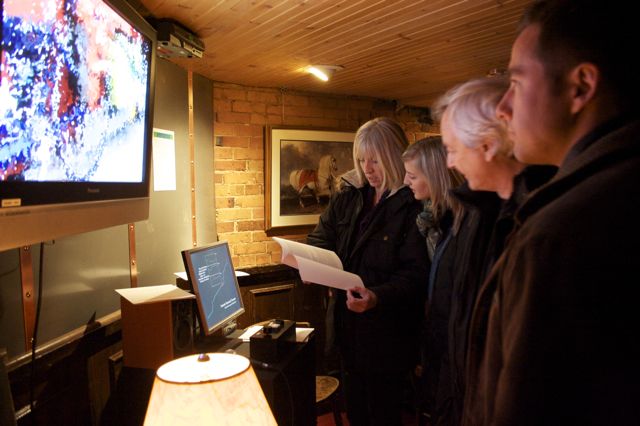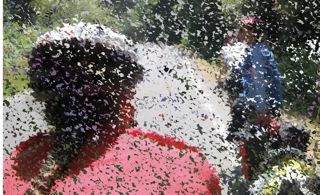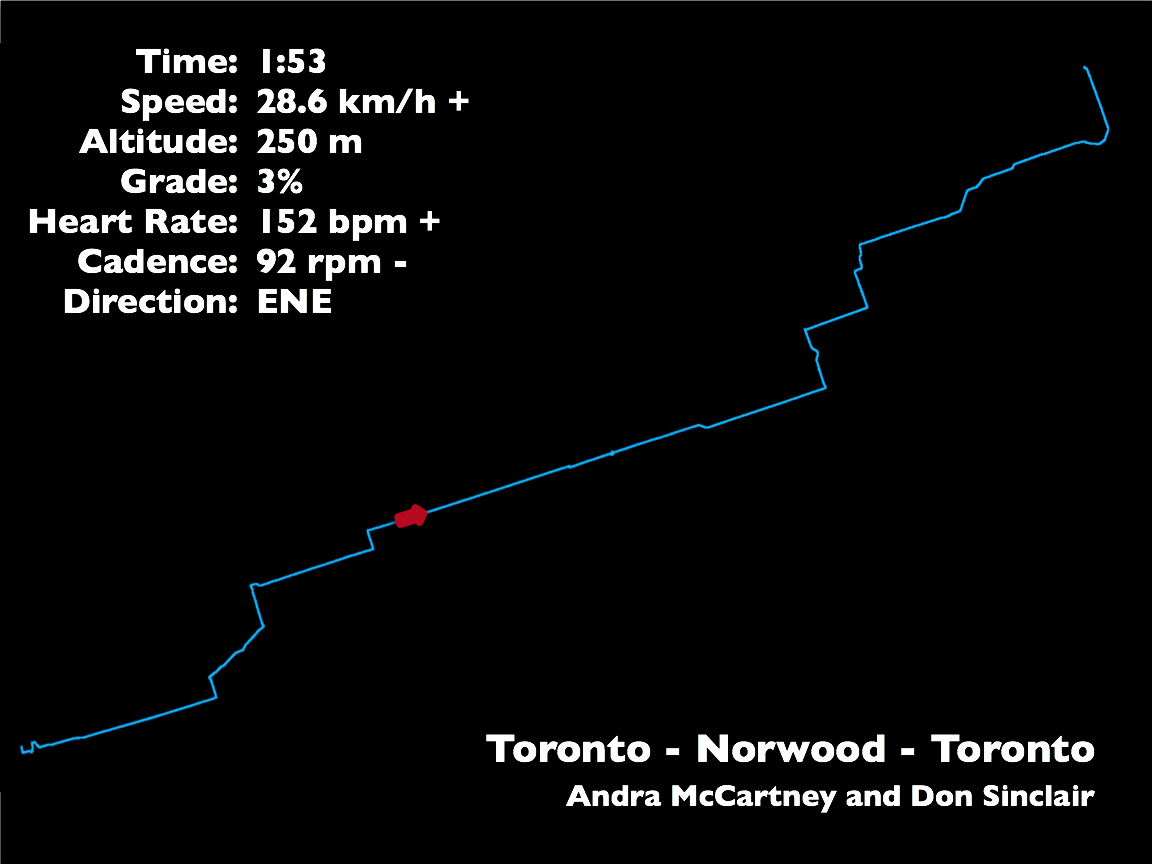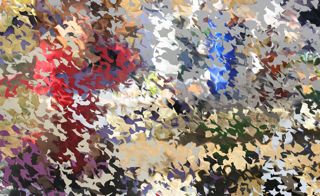Concept
For the past two years, Don Sinclair has been riding from Toronto to Norwood to meet with Andra McCartney to collaborate on creative work. The trip is about 165 km each way. Don would cycle out one day, stay overnight, work with Andra the next day and cycle back the third day.
This piece prompts the audience to immerse itself in the experience of a long distance cyclist through sound and image. Using data collected while cycling, this installation presents a dynamic sonification/visualization of data including speed, pedaling cadence, heart rate, elevation, grade etc. Audience members will interact with the journey through a straightforward interface that allows them to choose location and direction. At every point in the journey the installation presents and sonic/visual interpretation of the experience of the cyclist at that moment in the trip.
Data collection
While cycling, Don would use a Garmin Edge 305 with heart rate monitor and cadence sensor to collect data. The Garmin gathers the follow data every 5-7 seconds as necessary:
<Trackpoint> <Time>2007-06-02T13:29:22Z</Time> <Position> <LatitudeDegrees>43.781858</LatitudeDegrees> <LongitudeDegrees>-79.407128</LongitudeDegrees> </Position> <AltitudeMeters>201.533569</AltitudeMeters> <DistanceMeters>8986.294922</DistanceMeters> <HeartRateBpm xsi:type="HeartRateInBeatsPerMinute_t"> <Value>100</Value> </HeartRateBpm> <Cadence>80</Cadence> <SensorState>Absent</SensorState> </Trackpoint>
Over the course of the trip to and from Norwood the unit collects about 6,500 data points. The original data file is about 4MB or about 100,000 lines.
Data interpretation (sound/visual)
From this data we calculate: speed, direction, grade, averages, peaks, troughs, and relationships among parameters. Speed, cadence and heart rate are interrelated in complex ways that depend on the local context of the rider experience varied levels of effort, terrain, and weather conditions. Sonification and visualization of these parameters needs to be clearly articulated in order to provide a meaningful experience for the audience. The ability to both distinguish and compare parameters is critical to a complex understanding of this dynamic experience.
In the installation speed, cadence and heart rate are be differing sonic layers distinguished by texture, pitch and rhythm. In parallel, the projection visualizes the data using three dimensional manipulations that change their form, colour, and texture in rhythm.
Program Note:
This piece prompts audiences to engage with experiences of a long distance cyclist through sound, image and dialogue linked by rhythmic gesture. Data collected while cycling are presented dynamically through sonification/visualization of speed, pedaling cadence, heart rate, and direction. Audience members interact with the journey through a logbook and dials to choose location, direction and sound volume. The installation presents a sonic/visual interpretation of the experience of the cyclist at every moment through the thirteen hour trip. Sonic lines for pedaling cadence and speed are modulated from prepared electric guitar by Rainer Wiens; visuals are kaleidoscopic versions of everyday cycling life from a west coast US trip undertaken by Don and family. On that trip, they met cyclists who were on the road for a few days or weeks, as well as others who had left behind their everyday life to cycle for months on end. One family was home-schooling their children, and another cyclist had started in Alaska and was heading to the tip of South America. Cyclist groups would meet up at a campsite for a communal dinner; Don and family would see people for several days in a row sometimes. On long distance trips like these, mobile and changing communities are formed that make their ways down a coast or along a trail, with members coming and going from day to day.
We are interested in your bicycle stories. Please write in the spaces in this book. Please leave the book here so that others can take part in the conversation...
Do you ride a bicycle on city streets?In the countryside?
On bicycle paths?
How is your experience of cycling changed by the environment that you cycle through?
Do you notice your surroundings more or less while cycling?
Sensations, smells, tastes, sounds, views?
Is a bicycle part of your everyday life?
Have you ever taken a bicycle vacation?
Andra: I only ride bicycles on bike paths that are separate from roads, as car drivers make me nervous. For the past few years, I have been recording sounds around the Lachine canal, near Montreal. I sometimes record while cycling, by placing binaural mics in a helmet protected from the wind with nylon patches. I still have to cycle slowly so that I don't make too much wind -- but that is the way I prefer to cycle anyway. In the municipality of Lachine, all waterside areas are public parks with separate bike paths and walking trails. The bike paths continue along the Lachine canal to Old Montreal and beyond. The peninsula of land that used to be the main jetty of the Lachine canal is now a favourite destination of urban cyclists around Montreal.
Don: My bicycles are my primary means of transportation. My cycling includes year-round commuting/utilitarian, touring, off-road, and fast group training rides. I currently have five single bikes that get regular use: Surly 1X1 single-speed - snow bike with studded tire, Redline 9•2•5 single-speed/fixed gear - cold/cool fairer weather, Marinoni Ciclo - warmer weather commuting and touring, Cannondale V400 - off road, and Marinoni Delta - fast group rides and long day rides. We also own two Cannondale road tandems for getting around with the kids and touring. Over the past 20 years I have averaged over 10,000 km per year. For 15 months in 2004-05, I wore a time-lapse camera and GPS while riding to collect about 25,000 images all with associated location and weather data for a project I dubbed oh, those everyday spaces. The material gathered was used to create a series of works.
Toronto - Norwood - Toronto: Vital Statistics
| Ride dates/times: | June 18, 2007 9:30 - 4:30 and June 20, 2007 9:00 - 4:30 | |
|---|---|---|
| Distance: | 165.5 km | |
| Ascent: | 1550 m | |
| Altitude: | 80 - 300 m | |
| June 18 | June 20 | |
| Conditions: | mostly cloudy/rain | mostly cloudy |
| Temperature: | 21° - 25° C | 17° - 21° C |
| Humidity: | 45% - 76% | 50% |
| Wind speed: | 10 - 20 km/hr | 10 - 30 km/hr |
| Wind direction: | mostly SE (NE during rain) | WNW |
| Riding time: | 6:20:16 h:m:s | 6:51:21 h:m:s |
| Average speed: | 26.2 km/hr | 24.1 km/hr |
| Maximum speed: | 61.8 km/hr | 64.5 km/hr |
| Average heart rate: | 129 bpm | 123 bpm |
| Maximum heart rate: | 155 bpm | 146 bpm |
| Average cadence: | 86 rpm | 82 rpm |
Vancouver - San Francisco: Surveys
In the summer of 2006, Don, his partner Marianna and their two children, Stephanie (then 10) and Lucas (then 8) traveled from Vancouver to San Francisco. The trip took 35 days covering 1,700 kilometres. They traveled on two Cannondale tandems each pulling a Bob trailer and camped along the way. During the trip, Don surveyed traveling cyclists about their trips and took photos of them with the goal of using the material in future artworks. On the following pages you will find the surveys they filled out about their trips.
Technical requirements
The installation requires the following equipment.
- 2 speakers and cables
- video projector / large screen TV and second monitor (17" LCD)
- computer can be secured semi-remotely (with the ability display two screens)
- Max/MSP/Jitter
- monitor table or stand.
Artist Statements
Andra McCartney
My installation work examines relationships among sounds, subjectivities, spaces, and cultural contexts, and aims to engage audiences as collaborators in the art work. As a soundwalk artist, I work with my own field recordings to create websites, CD ROMs, tape works, and performances that explore the social ecology of soundscapes through the subjectivity of soundwalks. A soundwalk is a listening walk that takes a trajectory through a social space, using sound as an affective compass. My intention in doing installation work is to engage the audience on a number of different levels, inviting interaction in the form of written commentary, live mixing of the sound, active discussions in public soundwalks surrounding the installation space, and commentary on the websites documenting the work. Future projects are fundamentally transformed through the work with audiences, and commentary is integrated into the show content. I understand my role as a facilitator and provocateur of audience creativity.
Don Sinclair
My artistic practice centers around exploring ideas and techniques for transforming experiences and gestures. At the crux of the interface between humans and computers are the relationships between what we do in the interface and what is experienced. My exploration of the interface currently involves two, sometimes overlapping, ideas. First, I am interested in exploring transformations both in the context of audience members’ gestures in a gallery or on the web, and performance gestures on stage. The basic question is how can human gestures be captured and transformed into other forms (sound, video, kinetic, etc.). Second, I am interested in creating interfaces to large sets of data created by documenting experiences electronically. With the advent of miniaturization and data storage, it becomes possible to collect a great deal of data. For instance, in oh, those everyday spaces data is collected while cycling: 1 image per minute, GPS (Global Positioning System) position, and local weather conditions. This large data set then becomes available as a basis for exploring ideas of place through interfaces to that data. Cycling has been a long time passion for me. I am a bit of a compulsive data gatherer as I track the mileage on my seven or so bikes monthly and have been doing so for many years. I have ridden over 200,000 km in the last 20 years. My projects based on cycling allow me to combine my passions for art, the outdoors and mathematics.
